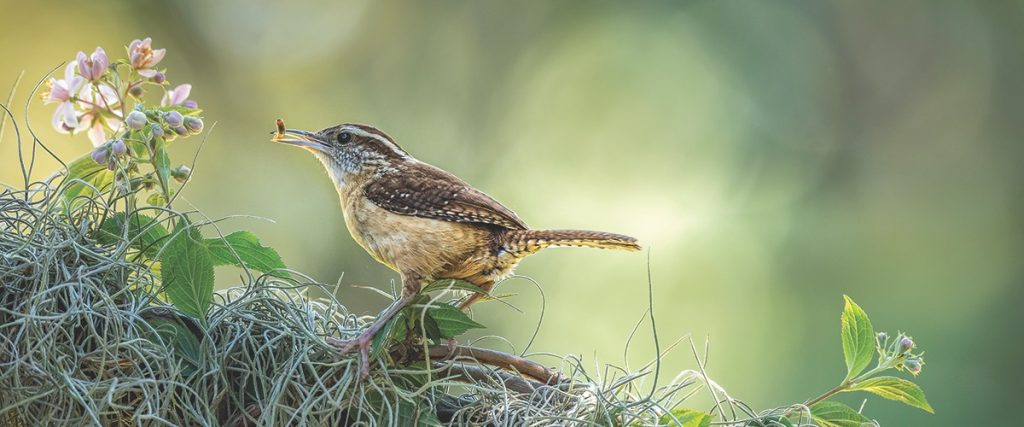Birdwatch

Playing a Cheerful Tune
The Carolina wren sings from dawn to dusk
By Susan Campbell
“Chirpity, chirpity, chirpity, chirp.” Or is it “teakettle, teakettle, teakettle, tea?” Or maybe “cheeseburger, cheeseburger, cheeseburger, cheese?” Regardless of exactly how it sounds, this bright, cheery song belies a small and drab bird — the Carolina wren. This diminutive critter is rufousy-brown with banded wings and tail. The thin, decurved bill is well-equipped to probe nooks and crannies for its favorite food: insects. Not only do they flit around in trees and vines looking for caterpillars, but they will clamber around on windows, doors and porch furniture for spiders and flies.
Common throughout the Piedmont year-round, Carolina wrens, the state bird of South Carolina, are frequently overlooked — until spring, when their songs can be heard echoing from forests and fields to neighborhoods here in central North Carolina. And a rarity among songbirds, both males and females sing, providing double pleasure. In fact, sometimes they can be heard in duets, advertising their territory, vocalizing repeatedly, any time from dawn to dusk.
At this time of the year, Carolina wrens are a common sight as they seek a protected spot to construct their nests. They frequently prefer houses, sheds or something else manmade over vegetated habitat. Though it may seem foolhardy to us, barbeque grills, bags of potting soil, an old coat or hat may actually provide a perfectly suitable nesting spot. The female will carry in small leaves, pine needles, grasses, moss or even feathers of other birds to create a large, bulky cup nest. She’ll finish it off with a partial roof to hide the eggs and young more effectively. Wrens don’t seem to mind people coming and going, a seemingly welcome trade-off for the protection humans provide from predators. Peek into one of their nests and more likely than not the female or brooding young will just stare back at you.
Sometimes nesting adults demonstrate great resiliency, or even cunning, in adapting to manmade structures. More than once, a Carolina wren female has chosen a nook on one of the trams that circle the North Carolina Zoo in Asheboro as a nesting site. The nesting adults sit tight as the vehicle bumps around the property during incubation. Once the young hatch, adults who leave the nest to find food simply wait for the tram (and nest) to return to the parking area to feed their young.
It should not be surprising, then, that these resourceful birds will find their way indoors during spring. If they can, they will squeeze under a door or through a cracked window in order to use the corner of a shelf in a shed or mudroom of a house. When fledging day arrives, the parents simply call the young from the nest and show them how to slip outside. Be prepared for the whole brood to find its way back in and crowd into the nest to roost for days, or even weeks, thereafter.
Each winter I get calls about mysterious critters sleeping on high ledges or porches and carports. Described as small brown balls, these unidentified sleeping objects almost inevitably turn out to be roosting Carolina wrens. After a yawn or two, wrens tuck their heads under their wings to roost, puffing themselves up and looking decidedly unbirdlike. They may also spend the night hunkered down in a potted plant or basket, frightening the daylights out of anyone who, next morning, comes upon them unaware.
Every year around the holidays, I’ll get a call or two about an unexpected Christmas guest. Seeking the warmest spot they can find, Carolina wrens often decide to huddle up in someone’s Christmas wreath. When subsequent visitors open the front door, the wren instinctively flies toward the brightest light — inside the house, occasioning merry and sometimes frantic holiday antics as everyone shares their favorite scheme for getting the bird back outside where it belongs.
So, if you have ever noticed these birds before, you should not have to go too far to find one — unless it finds you first. PS
Susan Campbell would love to receive your wildlife sightings and photographs at susan@ncaves.com.
